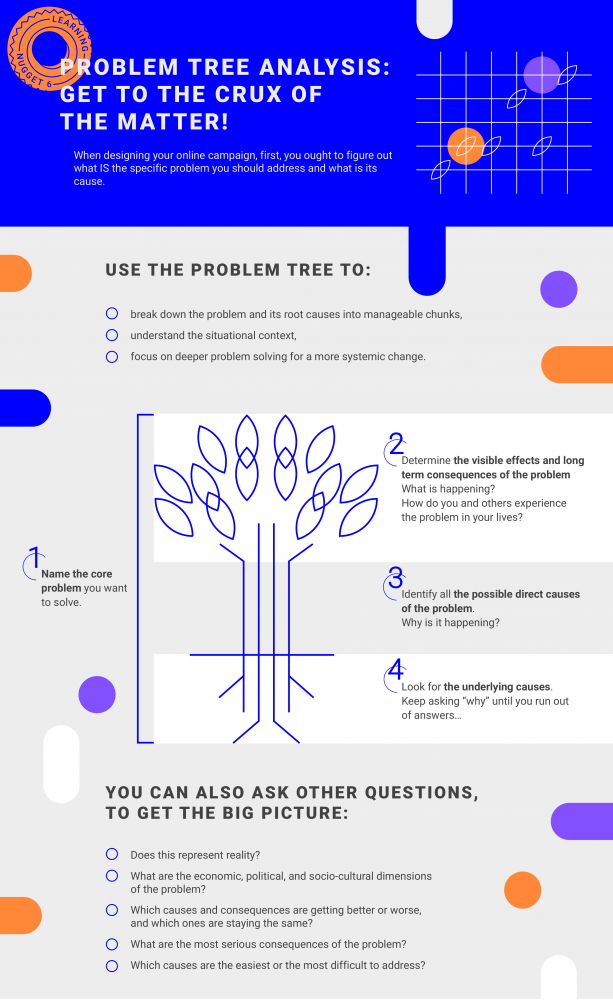Understanding your challenge
The problems we tend to address in campaigning are complex in nature. They are made up of several elements. Therefore, we can use a special tool, called “The Problem Tree”, to break down the problem into more digestible parts. This kind of detailed analysis will help us get to the problem's origins, consequences, or symptoms. It will let us focus on the deeply rooted, systemic causes of the problem.
We use the “Problem Tree” tool to:
break down the problem and its root causes into manageable chunks,
understand the situational context,
focus on deeper problem solving for a more systemic change.
The imminent results stemming from the problem are often perceived in what we see directly around us; this is how we tend to experience them. These results point to the fact that there is a problem and create an urgency to solve it.
Fixing symptoms is not the same as addressing root causes
Focusing on the short-term impact of a given problem is important and necessary in order to prevent people and the environment from the harm it carries. The urgency is real: people are suffering and dying, the climate is changing, and yet another species is being lost.
Much of what civil society organizations do is the pragmatic and important work of helping the poor and the sick, the marginalized ones and the environment in real time. We need to acknowledge, however, that fixing symptoms is not the same as dealing with the underlying causes of the problem. Campaigns that don’t deal with root causes can create an illusion that they will solve problems, when in fact, they won’t.
In order to stop the problem in the long run, we need to nip it in the bud.
We’ve got to dig deeper and uncover what are the real causes of the problem.
This means asking ourselves WHY the problem is happening. What are some of its direct causes? And this is exactly where “The Problem Tree” can come in handy!
5 Steps to Develop Your Problem Tree
Step One
Start with identifying the core problem you’d like to solve. If you’re not sure how to define it, we recommend you check out the “Online Campaigning | Part 1” course and learn more about defining the problem statement by using “The 4Ws” method.
Step Two
Think of and note down all the visible effects of the problem. How do you and others experience the problem in your lives? What are some of the long term consequences of the problem? Your answers are the branches of the Problem Tree.
Step Three
Try to map out all the possible causes of the problem. Why is it happening? What are the direct causes of the problem? The so-called “root causes” are like a trunk of the tree and the roots you can see overground.
Step Four
Focus on the deepening of the question “WHY”: What are the underlying causes? Keep thinking “why”, until you run out of answers…This way, you map out the deep roots of the problem, represented as the underground roots: hidden from view, supporting the whole tree, and tied to the entire system.
Step Five
During this exercise, you might also ask other questions that can help you see the big picture:
Does this model I created represent reality?
What are the economic, political, and socio-cultural dimensions of the problem?
Which causes and consequences are getting better or worse, and which ones are staying the same?
What are the most serious consequences of the problem?
Which causes are the easiest or the most difficult to address?
Try to analyze the whole problem, not just the elements you have already identified. This way you will get a better understanding of the context and inter-relationship among the issues defined. Sometimes, it is exactly where you will find the best ideas on how to find a win-win solution.
In addition, “The Problem Tree” can also be helpful for further mapping out of all the stakeholders to be involved in the process and planning the actions constituting the campaign.
Here's a downloadable infographic summarising the model:
If you want to learn more about “The Problem Tree” tool, register for the “Digital Campaigning Basics” course:

